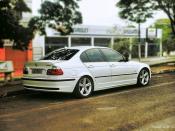Introduction
BMW has been established in 1916 and, by later diversifying into its main products, automobiles and motorbikes, turned out to be one of Germany's largest and most successful companies by the year 2002. BMW has a high reputation for product quality and advanced engineering, as well as a highly skilled work force. The company has always followed a strategy of limited diversification, sticking to its core values of premium and luxury cars. An attempt to broaden its product range by the acquisition of Rover automobiles from the UK in 1994 had not been successful and resulted eventually in the sale of Rover, excluding the Mini brand which was incorporated into the BMW Group. Since 1 January 2003, BMW has also taken over the brand responsibility for Rolls-Royce motor cars, thus reaching the top-end of the luxury segment (Annual report 2002).
Today, BMW is facing a highly competitive market which is dominated by global convergence, internationalisation and regulatory forces.
High numbers of mergers and acquisitions in the automobile industry lead to an ever decreasing number of global giants, pressuring middle-sized players to merge in order to survive. Furthermore, economic recession and rising unemployment rates have had a strong impact on the automobile industry.
The aim of this report is to identify the key environmental influences, competitive forces and internal factors affecting the current situation of BMW. As the focus will be set on the key issues, further factors affecting the organisation can be found in the appendix where theoretical frameworks will be fully applied.
The second part of the report will be dedicated to recommendations on how BMW should respond to the changing nature of the environment that they operate in taking account of internal competencies and issues. The scope of the analysis will only cover the European market.



Where is the appendix
I would be happy with this essay if I could access the appendix how do I do this?
3 out of 3 people found this comment useful.